With Biodesign, Life is Not Only the Subject of Art, But the Medium Too
Artists are borrowing from biology to create dazzling “biodesigns” that challenge our aesthetics—and our place in nature
![]()
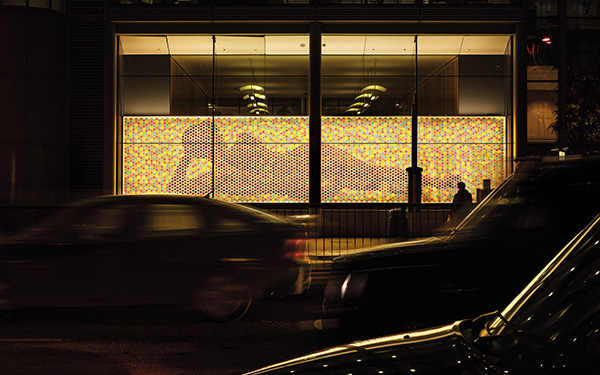
“This project was inspired by the universe of unseen organisms that inhabit our bodies,” author William Myers says of Julia Lohmann’s mural Co-Existence exhibited in 2009 in London. Photo courtesy of The Wellcome Trust.
When Julia Lohmann set out to create an artwork for the street-level windows of the London headquarters of the Wellcome Trust, the health research foundation, she chose a classic subject: the female body. But where Lohmann broke from tradition was her medium. The German designer created her large-scale portrait of two reclining nudes using 9,000 petri dishes, each containing an image of live bacteria.
Suzanne Lee, a British fashion designer, is attempting to grow clothes. She cultivates bacteria in vats of sugary green tea and then harvests the cellulose that forms on the mixture’s surface. The durable film serves as a pleatherlike fabric.
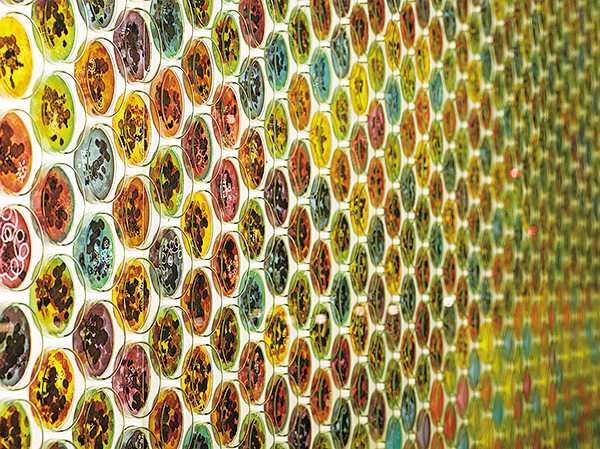
Thousands of petri dishes contain images of colored gels and actual colonies of microbes from a female body that were grown in a laboratory. Photo courtesy of Julia Lohmann Studio.
The Italian artist Giuliano Mauri planted 80 hornbeam trees amid columns of bundled branches in Arte Sella, a sculpture garden in northern Italy. The trees inch up the columns to form Cattedrale Vegetale, a Gothic cathedral complete with naves.
All these works are prominent examples of a nascent aesthetic movement called biodesign, which integrates living things, including bacteria, plants and animals, into installations, products and artworks. “Designers and architects, more and more, want to design objects and buildings that grow by themselves,” says Paola Antonelli, design curator at the Museum of Modern Art.
Biodesign takes advantage of the “tremendous power and potential utility of organisms and their natural interaction with ecosystems around them,” says William Myers, a New York City design historian and author of the new book Bio Design: Nature + Science + Creativity. “It can be a means of communication and discovery, a way to provoke debate and explore the potential opportunities and dangers of manipulating life for human purposes.”
Some ventures are very down-to-earth. Microbiologist Henk Jonkers at the Delft University of Technology in the Netherlands is developing self-repairing “bio-concrete”; he adds limestone-producing bacteria to cement and, over time, they fill in cracks. If adopted widely, the material could benefit the environment, since concrete production is a major source of atmospheric carbon dioxide.
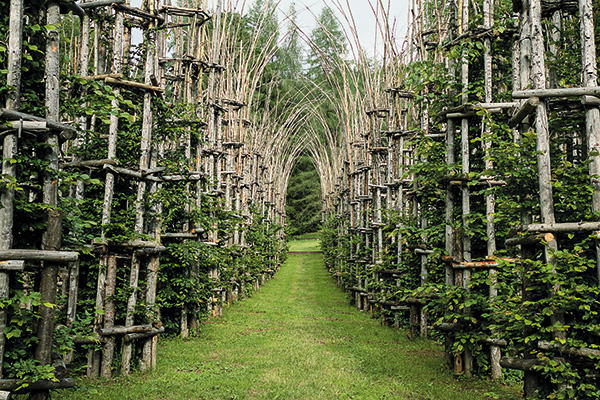
Giuliano Mauri’s Cattedrale Vegetale is organic architecture in more ways than one. Eighty columns, fashioned from branches, outline a Gothic cathedral. Photo courtesy of Aldo Fedele / Arte Sella.
Other proposals read more like science fiction. Alberto Estévez, an architect based in Barcelona, wants to replace streetlights with glowing trees created by inserting a bioluminescent jellyfish gene into the plants’ DNA.
The biodesign movement builds on ideas in Janine Benyus’ trailblazing 1997 book Biomimicry, which urges designers to look to nature for inspiration. But instead of copying living things biodesigners make use of them.
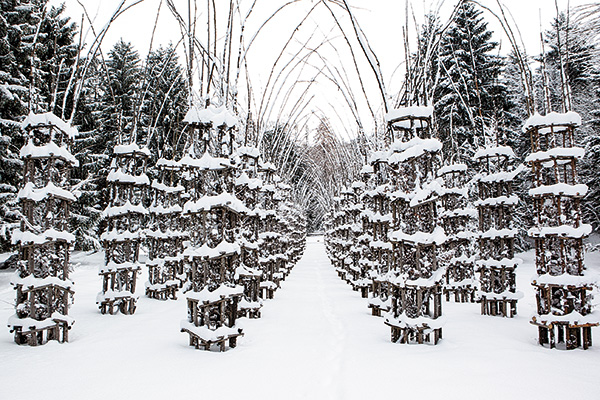
Hornbeam trees planted within the columns will eventually form the roof, nearly 70 feet high. Then, in time, the columns will disintegrate, becoming fertilizer that will nourish the living structure. Photo courtesy of Aldo Fedele / Arte Sella.
The effort brings artists and scientists together. “These novel collaborations are often joyous contaminations in which scientists feel, even just for a moment, liberated from the rigor of peer review and free to attempt intuitive leaps,” Antonelli writes in a foreword to Bio Design.
Julia Lohmann teamed up with Michael Wilson, a microbiologist at University College London Eastman Dental Institute. Wilson, who studies the bacteria that inhabit people, grew common bacteria from the female body and photographed the colonies under a microscope. Lohmann affixed these photographs to actual petri dishes and positioned each type of bacteria where it would occur on or in a woman’s body—pictures of the scalp microbe Propionibacteria, for instance, cover the head.
“The petri dish is a magnifying glass into this other world,” says Lohmann, who was inspired by the mind-bending fact that only one in ten cells in the human body is actually human. The rest are microbes. “There is so much advertising out there that tells you that all bacteria are bad, and it is simply not true. We couldn’t live without bacteria, and they couldn’t live without us,” says Lohmann. She considers her mural Co-existence to be part of the counter propaganda.
/https://tf-cmsv2-smithsonianmag-media.s3.amazonaws.com/accounts/headshot/megan.png)
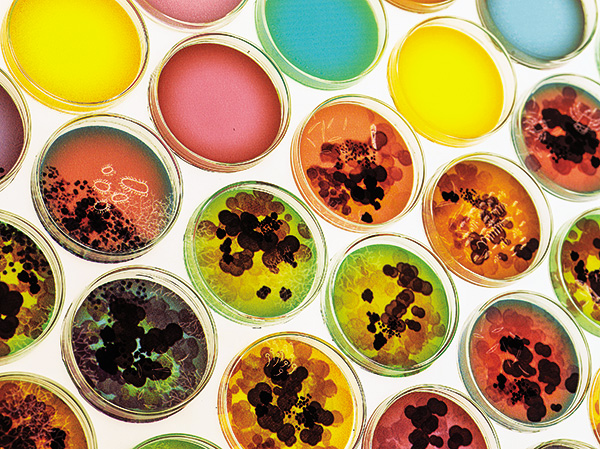
/https://tf-cmsv2-smithsonianmag-media.s3.amazonaws.com/accounts/headshot/megan.png)